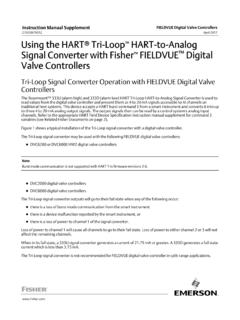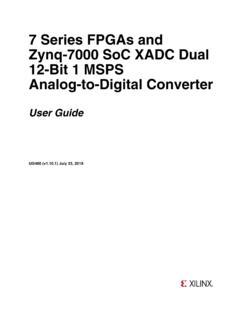Transcription of 22. ANALOG INPUTS AND OUTPUTS - infoPLC
1 371. 22. ANALOG INPUTS AND OUTPUTS . Topics: ANALOG INPUTS and OUTPUTS Sampling issues; aliasing, quantization error, resolution ANALOG I/O with a PLC. Objectives: To understand the basics of conversion to and from ANALOG values. Be able to use ANALOG I/O on a PLC. INTRODUCTION. An ANALOG value is continuous, not discrete, as shown in Figure 308. In the previous chapters, techniques were discussed for designing logical control systems that had INPUTS and OUTPUTS that could only be on or off. These systems are less common than the logical control systems, but they are very important. In this chapter we will examine ANALOG INPUTS and OUTPUTS so that we may design continuous control systems in a later chapter. Voltage or Current logical continuous t Figure 308 Logical and Continuous Values Typical ANALOG INPUTS and OUTPUTS for PLCs are listed below.
2 Actuators and sensors that can be used with ANALOG INPUTS and OUTPUTS will be discussed in later chapters. INPUTS : oven temperature fluid pressure fluid flow rate OUTPUTS : fluid valve position motor position motor velocity 372. This chapter will focus on the general principles behind digital -to- ANALOG (D/A) and ANALOG -to- digital (A/D) conversion. The chapter will show how to output and input ANALOG values with a PLC. ANALOG INPUTS . To input an ANALOG voltage (into a PLC or any other computer) the continuous voltage value must be sampled and then converted to a numerical value by an A/D converter. Figure 309 shows a con- tinuous voltage changing over time. There are three samples shown on the figure. The process of sam- pling the data is not instantaneous, so each sample has a start and stop time. The time required to acquire the sample is called the sampling time.
3 A/D converters can only acquire a limited number of samples per second. The time between samples is called the sampling period T, and the inverse of the sampling period is the sampling frequency (also called sampling rate). The sampling time is often much smaller than the sampling period. The sampling frequency is specified when buying hardware, but for a PLC a maximum sampling rate might be 20Hz. Voltage is sampled during these time periods voltage time T = (Sampling Frequency)-1 Sampling time Figure 309 Sampling an ANALOG Voltage A more realistic drawing of sampled data is shown in Figure 310. This data is noisier, and even between the start and end of the data sample there is a significant change in the voltage value. The data value sampled will be somewhere between the voltage at the start and end of the sample. The maximum (Vmax) and minimum (Vmin) voltages are a function of the control hardware.
4 These are often specified when purchasing hardware, but reasonable ranges are;. 0V to 5V. 0V to 10V. -5V to 5V. -10V to 10V. 373. The number of bits of the A/D converter is the number of bits in the result word. If the A/D con- verter is 8 bit then the result can read up to 256 different voltage levels. Most A/D converters have 12. bits, 16 bit converters are used for precision measurements. V(t). V max V ( t2 ). V ( t1 ). V min t . t1 t2. where, V ( t ) = the actual voltage over time = sample interval for A/D converter t = time t 1, t 2 = time at start,end of sample V ( t 1 ), V ( t 2 ) = voltage at start, end of sample V min, V max = input voltage range of A/D converter N = number of bits in the A/D converter Figure 310 Parameters for an A/D Conversion The parameters defined in Figure 310 can be used to calculate values for A/D converters.
5 These equations are summarized in Figure 311. Equation 1 relates the number of bits of an A/D converter to the resolution. In a normal A/D converter the minimum range value, Rmin, is zero, however some devices will provide 2's compliment negative numbers for negative voltages. Equation 2 gives the error that can be expected with an A/D converter given the range between the minimum and maximum volt- ages, and the resolution (this is commonly called the quantization error). Equation 3 relates the voltage range and resolution to the voltage input to estimate the integer that the A/D converter will record. Finally, equation 4 allows a conversion between the integer value from the A/D converter, and a voltage in the computer. 374. R = 2. N. = R max R min (1). V max V min (2). V ERROR = ----------------------------- . 2R . V in V min V I = INT ----------------------------- ( R 1 ) + R min (3).
6 V max V min . V I R min V C = ---------------------- ( V max V min ) + V min (4). (R 1) . where, R, R min, R max = absolute and relative resolution of A/D converter V I = the integer value representing the input voltage V C = the voltage calculated from the integer value V ERROR = the maximum quantization error Figure 311 A/D Converter Equations Consider a simple example, a 10 bit A/D converter can read voltages between -10V and 10V. This gives a resolution of 1024, where 0 is -10V and 1023 is +10V. Because there are only 1024 steps there is a maximum error of If a voltage of is input into the PLC, the A/D converter converts the voltage to an integer value of 745. When we convert this back to a voltage the result is The resulting quantization error is + This error can be reduced by selecting an A/D converter with more bits. Each bit halves the quantization error.
7 375. Given, N = 10, R min = 0. V max = 10V. V min = 10V. V in = Calculate, N. R = R max = 2 = 1024. V max V min V ERROR = ----------------------------- = 2R. V in V min V I = INT ----------------------------- ( R 1 ) + 0 = 745. V max V min . VI 0. V C = -------------- ( V max V min ) + V min = R 1 . Figure 312 Sample Calculation of A/D Values If the voltage being sampled is changing too fast we may get false readings, as shown in Figure 313. In the upper graph the waveform completes seven cycles, and 9 samples are taken. The bottom graph plots out the values read. The sampling frequency was too low, so the signal read appears to be different that it actually is, this is called aliasing. Figure 313 Low Sampling Frequencies Cause Aliasing 376. The Nyquist criterion specifies that sampling frequencies should be at least twice the frequency of the signal being measured, otherwise aliasing will occur.
8 The example in Figure 313 violated this principle, so the signal was aliased. If this happens in real applications the process will appear to oper- ate erratically. In practice the sample frequency should be 4 or more times faster than the system fre- quency. f AD > 2f signal where, f AD = sampling frequency f signal = maximum frequency of the input There are other practical details that should be considered when designing applications with ANALOG INPUTS ;. Noise - Since the sampling window for a signal is short, noise will have added effect on the signal read. For example, a momentary voltage spike might result in a higher than normal reading. Shielded data cables are commonly used to reduce the noise levels. Delay - When the sample is requested, a short period of time passes before the final sample value is obtained. Multiplexing - Most ANALOG input cards allow multiple INPUTS .
9 These may share the A/D con- verter using a technique called multiplexing. If there are 4 channels using an A/D converter with a maximum sampling rate of 100Hz, the maximum sampling rate per channel is 25Hz. Signal Conditioners - Signal conditioners are used to amplify, or filter signals coming from transducers, before they are read by the A/D converter. Resistance - A/D converters normally have high input impedance (resistance), so they do not affect circuits they are measuring. Single Ended INPUTS - Voltage INPUTS to a PLC can use a single common for multiple INPUTS , these types of INPUTS are called single ended INPUTS . These tend to be more prone to noise. Double Ended INPUTS - Each double ended input has its own common. This reduces problems with electrical noise, but also tends to reduce the number of INPUTS by half. 377. ASIDE: This device is an 8 bit A/D converter.
10 The main concept behind this is the succes- sive approximation logic. Once the reset is toggled the converter will start by setting the most significant bit of the 8 bit number. This will be converted to a voltage Ve that is a function of the +/-Vref values. The value of Ve is compared to Vin and a simple logic check determines which is larger. If the value of Ve is larger the bit is turned off. The logic then repeats similar steps from the most to least significant bits. Once the last bit has been set on/off and checked the conversion will be complete, and a done bit can be set to indicate a valid conversion value. Vin above (+ve) or below (-ve) Ve Vin +. - +Vref successive 8. approximation D to A. clock converter logic Ve reset done -Vref 8. data out Quite often an A/D converter will multiplex between various INPUTS . As it switches the voltage will be sampled by a sample and hold circuit.













